Youngbin Kim
From Ground Trust to Truth: Disparities in Offensive Language Judgments on Contemporary Korean Political Discourse
Sep 18, 2025Abstract:Although offensive language continually evolves over time, even recent studies using LLMs have predominantly relied on outdated datasets and rarely evaluated the generalization ability on unseen texts. In this study, we constructed a large-scale dataset of contemporary political discourse and employed three refined judgments in the absence of ground truth. Each judgment reflects a representative offensive language detection method and is carefully designed for optimal conditions. We identified distinct patterns for each judgment and demonstrated tendencies of label agreement using a leave-one-out strategy. By establishing pseudo-labels as ground trust for quantitative performance assessment, we observed that a strategically designed single prompting achieves comparable performance to more resource-intensive methods. This suggests a feasible approach applicable in real-world settings with inherent constraints.
Delving into Multilingual Ethical Bias: The MSQAD with Statistical Hypothesis Tests for Large Language Models
May 25, 2025Abstract:Despite the recent strides in large language models, studies have underscored the existence of social biases within these systems. In this paper, we delve into the validation and comparison of the ethical biases of LLMs concerning globally discussed and potentially sensitive topics, hypothesizing that these biases may arise from language-specific distinctions. Introducing the Multilingual Sensitive Questions & Answers Dataset (MSQAD), we collected news articles from Human Rights Watch covering 17 topics, and generated socially sensitive questions along with corresponding responses in multiple languages. We scrutinized the biases of these responses across languages and topics, employing two statistical hypothesis tests. The results showed that the null hypotheses were rejected in most cases, indicating biases arising from cross-language differences. It demonstrates that ethical biases in responses are widespread across various languages, and notably, these biases were prevalent even among different LLMs. By making the proposed MSQAD openly available, we aim to facilitate future research endeavors focused on examining cross-language biases in LLMs and their variant models.
IM-BERT: Enhancing Robustness of BERT through the Implicit Euler Method
May 11, 2025Abstract:Pre-trained Language Models (PLMs) have achieved remarkable performance on diverse NLP tasks through pre-training and fine-tuning. However, fine-tuning the model with a large number of parameters on limited downstream datasets often leads to vulnerability to adversarial attacks, causing overfitting of the model on standard datasets. To address these issues, we propose IM-BERT from the perspective of a dynamic system by conceptualizing a layer of BERT as a solution of Ordinary Differential Equations (ODEs). Under the situation of initial value perturbation, we analyze the numerical stability of two main numerical ODE solvers: the explicit and implicit Euler approaches. Based on these analyses, we introduce a numerically robust IM-connection incorporating BERT's layers. This strategy enhances the robustness of PLMs against adversarial attacks, even in low-resource scenarios, without introducing additional parameters or adversarial training strategies. Experimental results on the adversarial GLUE (AdvGLUE) dataset validate the robustness of IM-BERT under various conditions. Compared to the original BERT, IM-BERT exhibits a performance improvement of approximately 8.3\%p on the AdvGLUE dataset. Furthermore, in low-resource scenarios, IM-BERT outperforms BERT by achieving 5.9\%p higher accuracy.
DIAL: Dense Image-text ALignment for Weakly Supervised Semantic Segmentation
Sep 24, 2024
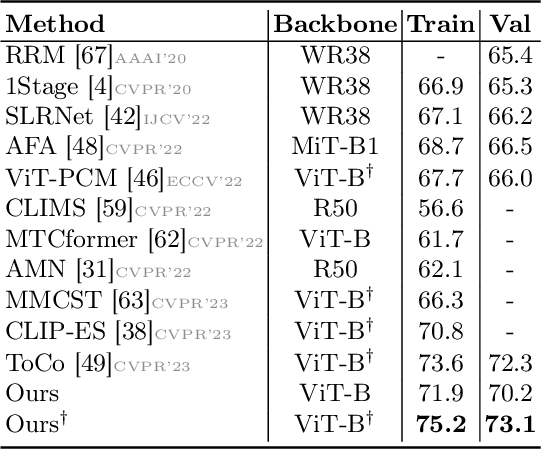
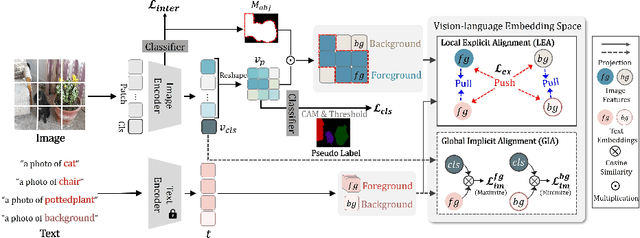
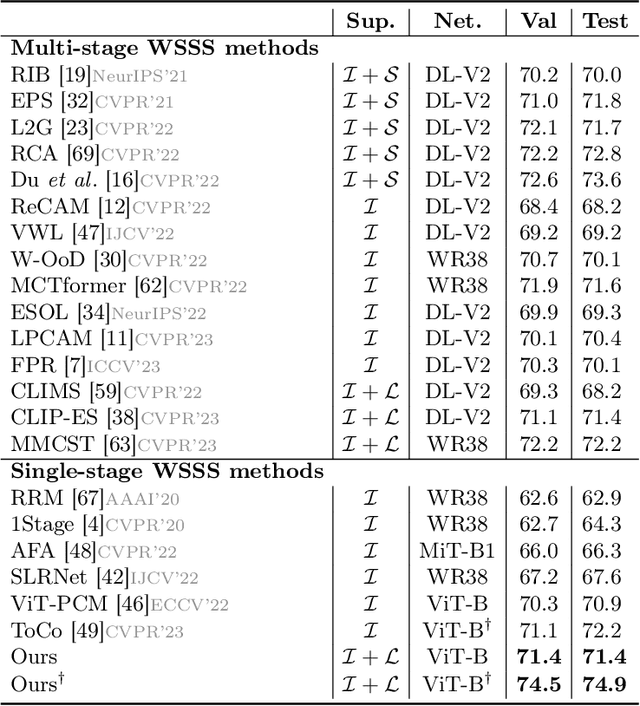
Abstract:Weakly supervised semantic segmentation (WSSS) approaches typically rely on class activation maps (CAMs) for initial seed generation, which often fail to capture global context due to limited supervision from image-level labels. To address this issue, we introduce DALNet, Dense Alignment Learning Network that leverages text embeddings to enhance the comprehensive understanding and precise localization of objects across different levels of granularity. Our key insight is to employ a dual-level alignment strategy: (1) Global Implicit Alignment (GIA) to capture global semantics by maximizing the similarity between the class token and the corresponding text embeddings while minimizing the similarity with background embeddings, and (2) Local Explicit Alignment (LEA) to improve object localization by utilizing spatial information from patch tokens. Moreover, we propose a cross-contrastive learning approach that aligns foreground features between image and text modalities while separating them from the background, encouraging activation in missing regions and suppressing distractions. Through extensive experiments on the PASCAL VOC and MS COCO datasets, we demonstrate that DALNet significantly outperforms state-of-the-art WSSS methods. Our approach, in particular, allows for more efficient end-to-end process as a single-stage method.
Focus on the Core: Efficient Attention via Pruned Token Compression for Document Classification
Jun 03, 2024Abstract:Transformer-based models have achieved dominant performance in numerous NLP tasks. Despite their remarkable successes, pre-trained transformers such as BERT suffer from a computationally expensive self-attention mechanism that interacts with all tokens, including the ones unfavorable to classification performance. To overcome these challenges, we propose integrating two strategies: token pruning and token combining. Token pruning eliminates less important tokens in the attention mechanism's key and value as they pass through the layers. Additionally, we adopt fuzzy logic to handle uncertainty and alleviate potential mispruning risks arising from an imbalanced distribution of each token's importance. Token combining, on the other hand, condenses input sequences into smaller sizes in order to further compress the model. By integrating these two approaches, we not only improve the model's performance but also reduce its computational demands. Experiments with various datasets demonstrate superior performance compared to baseline models, especially with the best improvement over the existing BERT model, achieving +5%p in accuracy and +5.6%p in F1 score. Additionally, memory cost is reduced to 0.61x, and a speedup of 1.64x is achieved.
Enhancing Effectiveness and Robustness in a Low-Resource Regime via Decision-Boundary-aware Data Augmentation
Mar 22, 2024Abstract:Efforts to leverage deep learning models in low-resource regimes have led to numerous augmentation studies. However, the direct application of methods such as mixup and cutout to text data, is limited due to their discrete characteristics. While methods using pretrained language models have exhibited efficiency, they require additional considerations for robustness. Inspired by recent studies on decision boundaries, this paper proposes a decision-boundary-aware data augmentation strategy to enhance robustness using pretrained language models. The proposed technique first focuses on shifting the latent features closer to the decision boundary, followed by reconstruction to generate an ambiguous version with a soft label. Additionally, mid-K sampling is suggested to enhance the diversity of the generated sentences. This paper demonstrates the performance of the proposed augmentation strategy compared to other methods through extensive experiments. Furthermore, the ablation study reveals the effect of soft labels and mid-K sampling and the extensibility of the method with curriculum data augmentation.
Don't be a Fool: Pooling Strategies in Offensive Language Detection from User-Intended Adversarial Attacks
Mar 20, 2024



Abstract:Offensive language detection is an important task for filtering out abusive expressions and improving online user experiences. However, malicious users often attempt to avoid filtering systems through the involvement of textual noises. In this paper, we propose these evasions as user-intended adversarial attacks that insert special symbols or leverage the distinctive features of the Korean language. Furthermore, we introduce simple yet effective pooling strategies in a layer-wise manner to defend against the proposed attacks, focusing on the preceding layers not just the last layer to capture both offensiveness and token embeddings. We demonstrate that these pooling strategies are more robust to performance degradation even when the attack rate is increased, without directly training of such patterns. Notably, we found that models pre-trained on clean texts could achieve a comparable performance in detecting attacked offensive language, to models pre-trained on noisy texts by employing these pooling strategies.
SoftEDA: Rethinking Rule-Based Data Augmentation with Soft Labels
Feb 08, 2024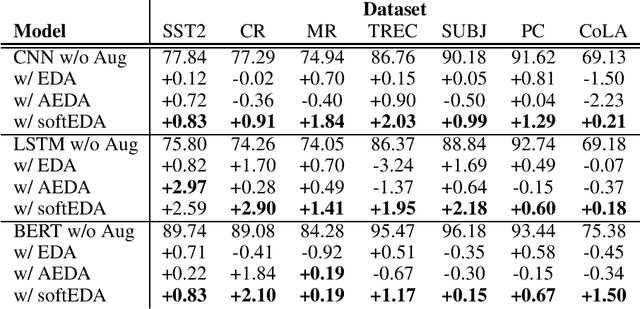

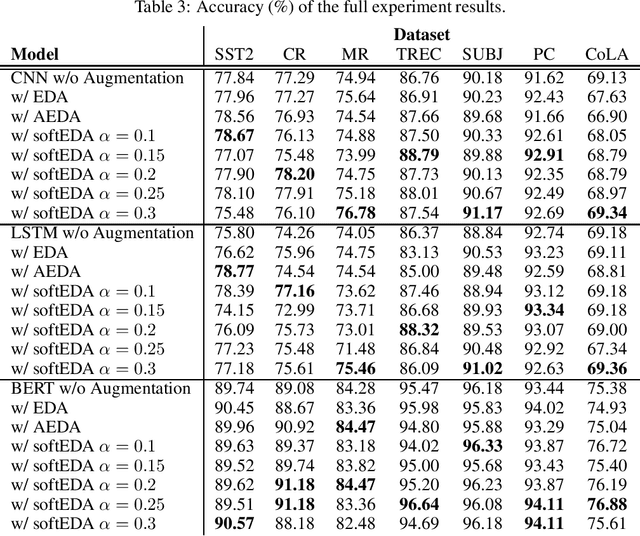
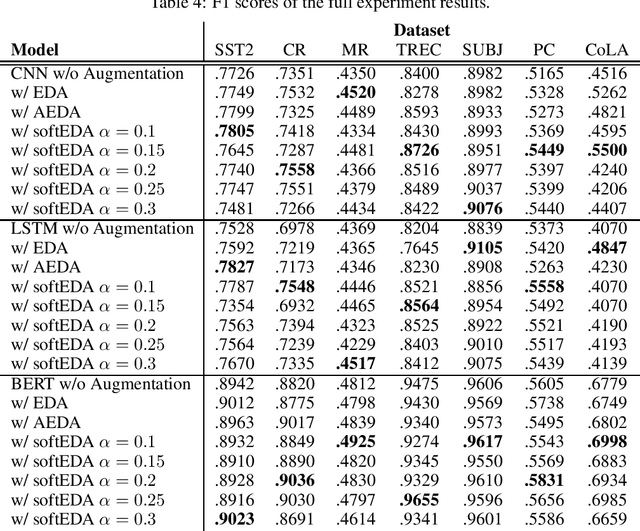
Abstract:Rule-based text data augmentation is widely used for NLP tasks due to its simplicity. However, this method can potentially damage the original meaning of the text, ultimately hurting the performance of the model. To overcome this limitation, we propose a straightforward technique for applying soft labels to augmented data. We conducted experiments across seven different classification tasks and empirically demonstrated the effectiveness of our proposed approach. We have publicly opened our source code for reproducibility.
AutoAugment Is What You Need: Enhancing Rule-based Augmentation Methods in Low-resource Regimes
Feb 08, 2024


Abstract:Text data augmentation is a complex problem due to the discrete nature of sentences. Although rule-based augmentation methods are widely adopted in real-world applications because of their simplicity, they suffer from potential semantic damage. Previous researchers have suggested easy data augmentation with soft labels (softEDA), employing label smoothing to mitigate this problem. However, finding the best factor for each model and dataset is challenging; therefore, using softEDA in real-world applications is still difficult. In this paper, we propose adapting AutoAugment to solve this problem. The experimental results suggest that the proposed method can boost existing augmentation methods and that rule-based methods can enhance cutting-edge pre-trained language models. We offer the source code.
Restoring and Mining the Records of the Joseon Dynasty via Neural Language Modeling and Machine Translation
May 07, 2021
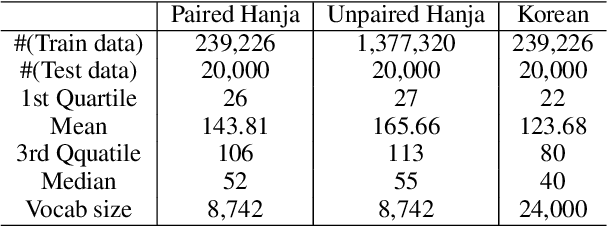
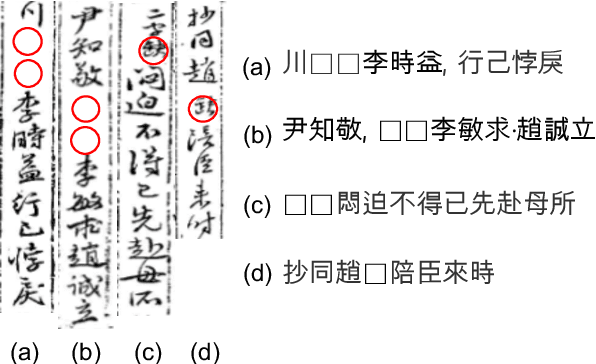

Abstract:Understanding voluminous historical records provides clues on the past in various aspects, such as social and political issues and even natural science facts. However, it is generally difficult to fully utilize the historical records, since most of the documents are not written in a modern language and part of the contents are damaged over time. As a result, restoring the damaged or unrecognizable parts as well as translating the records into modern languages are crucial tasks. In response, we present a multi-task learning approach to restore and translate historical documents based on a self-attention mechanism, specifically utilizing two Korean historical records, ones of the most voluminous historical records in the world. Experimental results show that our approach significantly improves the accuracy of the translation task than baselines without multi-task learning. In addition, we present an in-depth exploratory analysis on our translated results via topic modeling, uncovering several significant historical events.
 Add to Chrome
Add to Chrome Add to Firefox
Add to Firefox Add to Edge
Add to Edge